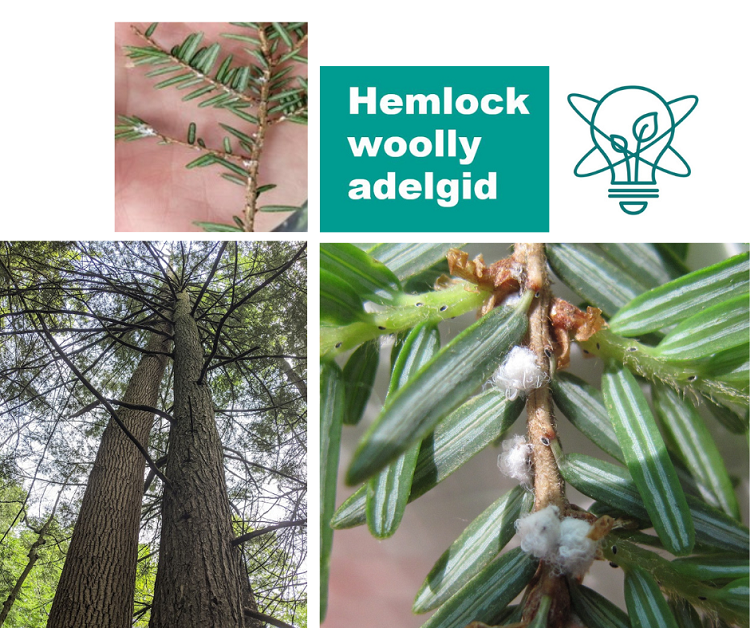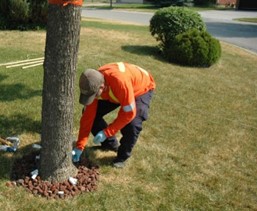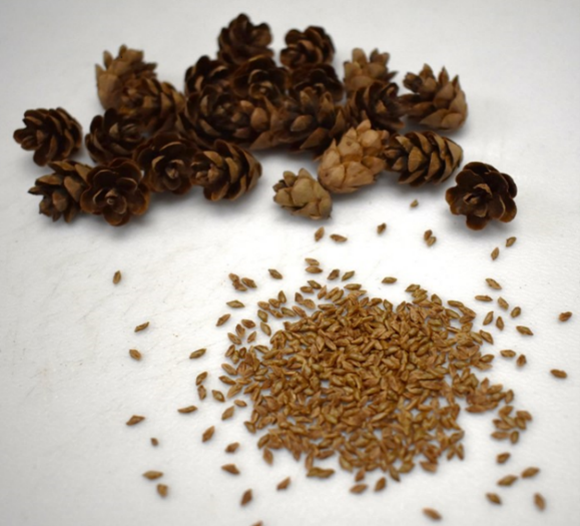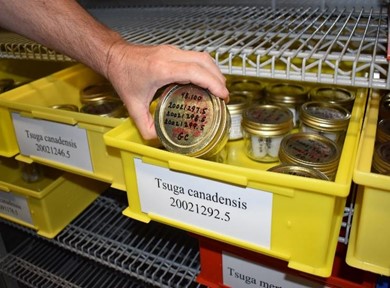When scientists from the Canadian Forest Service (CFS) and student researchers from the University of Guelph were collecting data to create an inventory of hemlock trees in Ontario, they found more than just trees — they discovered a large insect infestation that could pose a risk to landowners.
October 2022
To the untrained eye, the hemlock woolly adelgid (HWA) may be difficult to detect, but scientists can easily identify this threatening invasive forest pest. The tiny, aphid-like insect is about the size of a grain of pepper and covers itself in a white wool. It kills the tree by sucking the sap at the base of needles, draining the tree of its energy.

Hemlock woolly adelgid wool on a tree branch, with the black-pepper-grain–like adelgid at the base of the needles and the clumps of white wool wrapping around the insects as they feed. Hemlock trees thinned out by an HWA infestation. Photos: (left) Meghan Gray, NRCan, Chris MacQuarrie CFS (right) Becky Lidster, Ontario Ministry of Natural Resources.
Near Cobourg, Ontario, a town about 95 kilometres east of Toronto, the CFS crew saw large numbers of the insect as well as many dead hemlock trees, suggesting the insect has likely been present in that area for many years and may have spread beyond the known local areas of infestation.
The risk of HWA infestations
This newly discovered infestation is worrisome because it’s a long way from any other known populations and very close to forests with large amounts of hemlock. It’s also concerning because Cobourg’s hemlock forests extend to the Kawartha Lakes and Muskoka regions of Ontario. This combination of the insect’s spread and the forests’ range could put large stands of old-growth hemlocks at risk of further infestations. And the problem is compounded by the fact that the insect is difficult to stop: experts believe it spreads to new areas through infested nursery stock or by hitching a ride on the wind or on migrating birds.
The HWA is a familiar foe to eastern forests. Originally from Asia, it was first detected in North America in 1951 and has since killed hemlock forests across the eastern United States. In Canada, it was found in 2012 and 2013 in Toronto, Ontario, where it appears to have now been eradicated. Pockets of infestation were also found in the Niagara–Eastern Lake Erie area. In 2017, it was also discovered in southern Nova Scotia, where it has killed old-growth hemlock forests.

Research scientist Lucas Roscoe holding an experimental trap that was once used for monitoring HWA populations in southwestern Nova Scotia.
The spread of the insect has met with a strong response from NRCan scientists. Three CFS labs — the Atlantic Forestry Centre, the Great Lakes Forestry Centre and the Pacific Forestry Centre — are supporting research on tools to help detect, monitor, control and manage the serious threat posed by HWA.
Monitoring
Detecting populations as early as possible offers the best chance of minimizing tree damage and mortality. And the continuous monitoring of established HWA populations provides much valuable information on how populations are growing and spreading.
To detect HWA populations, experts rely upon visual assessments of twigs, looking on the undersides of twigs for the white, fluffy — each containing up to 300 eggs — that appear during fall and winter. Branch samples can also be collected at other times of the year when these ovisacs are not present.
Control

TreeAzin® treatment of an ash tree in Ontario
Research scientists Jon Sweeney, Chris Edge and Chris MacQuarrie are testing chemical insecticides to help prevent hemlock trees from dying due to HWA infestations. These include imidacloprid, which is applied at the base of the trunk or through injection. The team is also testing TreeAzin®, an insecticide derived from extracts of the seeds of the neem tree, a species of mahogany, which is applied by stem injection. Developed in Canada, TreeAzin® is currently approved for protecting ash trees from the emerald ash borer.
The team is assessing various aspects of these methods, measuring their efficacy and longevity, and monitoring the environmental fate of the insecticides, for instance, determining what concentrations are found in the foliage, soil and water. In collaboration with Acadia University, they’re also collecting data to determine any impacts on non-target organisms, specifically wild bee and fly pollinators as well as ground beetles.
Management

Eastern hemlock seeds and cones. Photo: Julie Root
Michael Stastny studies forest insect ecology: the complex interactions between insects, trees and their environment that underlie the functioning of our forests. He’s interested in how site conditions can exacerbate the impact of HWA on hemlock health. “For instance, if we know a particular stand is water-stressed,” says Michael, “we may be able to predict the severity of hemlock decline and mortality from HWA. This information will help us to identify the most vulnerable stands and focus our response.”
One such response could be stand-thinning — harvesting some competing trees to give the remaining hemlocks more access to water and light in order to improve their ability to tolerate HWA. Michael, in collaboration with CFS biologist Jeff Fidgen, is testing this forest management approach in experimental plots.
Proactive stand management, along with other control approaches, will also help woodlot owners and forest managers develop longer-term plans to rehabilitate their stands once HWA is detected. Given that the extent of hemlock stands under threat greatly exceeds the available resources for HWA management, Michael and Jeff are also working on developing a wider, systematic decision-making framework to help prioritize and select the most appropriate responses.
Other ways to manage HWA populations are also under development. One is the recruitment of natural enemies and their redistribution into areas where HWA is present. This approach could be especially valuable in eastern Canada. While the lack of natural enemies to regulate populations is a major factor in the spread of HWA there, several HWA predators can be found in the United States and western Canada, including a beetle (Laricobius nigrinus) and two silverfly species (Leucotaraxis argenticollis and piniperda). Introducing these or other predators to areas where there are no natural enemies could provide long-term and sustainable management control.

Eastern hemlock seeds in storage at the National Tree Seed Centre.
Thinking ahead: A careful backup plan
In addition to its HWA management efforts, NRCan is also establishing a backup plan. The National Tree Seed Centre, located at the CFS Atlantic Forestry Centre in Fredericton, New Brunswick, has 195 eastern hemlock seed lots carefully preserved in its lab, where temperature, light and humidity are strictly controlled. Seed Centre researchers will preserve more hemlock seeds over the next few years so that the species could be reintroduced in suitable environments where HWA has been controlled or eliminated.
Keeping the HWA at bay
As scientists and partners look to slow the spread of HWA and preserve hemlocks, the public also has an extremely important role to play. Keeping our eyes open, knowing where HWA and other harmful insects have been detected and taking simple precautions — like not moving firewood from one location to another — can have a big impact on slowing the spread of HWA helping protect our forests.
Side bar:
A team of experts is working together to keep the invasive HWA at bay. The Canadian Forest Service is collaborating closely with institutional partners — including Parks Canada, the Canadian Food Inspection Agency, the provincial governments of Ontario and Nova Scotia, the University of Guelph and Acadia University — and with individual conservation and environmental groups such as Ontario Nature, the Niagara Peninsula Conservation Authority and Canada’s Invasive Species Centre.
For more information on hemlock woolly adelgid and what you can do:
Natural Resources Canada (publication)